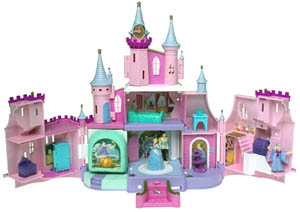Disney's Cinderella Musical Castle
Disney Princess : Cinderella Magical Musical Castle
 It's a dream come true as Disney's Cinderella whirls with the Prince on a spinning, sparkling, musical dance floor. Cinderella's ball gown glows with twinkling lights and music. Fairy Godmother transforms her from rags to riches. Use Fairy Godmother's magic wand for magical effects. Change the pumpkin into a carriage, and music plays. Then make the glass slipper appear on the step. Includes castle, wand, chest with pillow and glass slipper, bed, dresser, magical staircase and 3 figures. Includes 3 AAA batteries.
It's a dream come true as Disney's Cinderella whirls with the Prince on a spinning, sparkling, musical dance floor. Cinderella's ball gown glows with twinkling lights and music. Fairy Godmother transforms her from rags to riches. Use Fairy Godmother's magic wand for magical effects. Change the pumpkin into a carriage, and music plays. Then make the glass slipper appear on the step. Includes castle, wand, chest with pillow and glass slipper, bed, dresser, magical staircase and 3 figures. Includes 3 AAA batteries.
Fairy Godmothers in Literature
Fairy godmothers have long enchanted the pages of literature, weaving their magic and wisdom into countless stories across cultures and time periods. These enchanting figures serve as catalysts for transformation, guidance, and empowerment, leaving an indelible mark on the tales they inhabit:
Mythological Inspirations: The concept of benevolent supernatural beings dates back to ancient myths and legends, with figures like nymphs, spirits, and goddesses bestowing blessings and assistance upon mortal protagonists.
Charles Perrault's Influence: Charles Perrault's fairy tales, including "Cinderella" and "Sleeping Beauty," introduced the archetype of the fairy godmother to European literature. These magical characters bestow gifts and aid, ensuring the protagonists' destinies are fulfilled.
The Brothers Grimm: The Brothers Grimm added their own touch to the fairy godmother figure, with stories like "Hansel and Gretel" featuring magical creatures who assist the young protagonists in their quests.
Disney's Transformation: Disney adaptations brought fairy godmothers to life with characters like the Fairy Godmother in "Cinderella" and Flora, Fauna, and Merryweather in "Sleeping Beauty." These beloved characters bring heartwarming moments of guidance, transformation, and comic relief.
Modern Variations: Contemporary literature often reimagines fairy godmothers, presenting them as complex and diverse characters. Some tales explore the consequences of magical interventions, adding depth to their role in the narrative.
Symbolism of Guidance: Fairy godmothers symbolize guidance and mentorship, helping protagonists navigate challenges, make choices, and find their true selves. Their wisdom often imparts valuable life lessons.
Empowerment and Agency: Fairy godmothers empower protagonists to take control of their destinies, encouraging them to overcome adversity and transform their circumstances through their own efforts.
Cultural Variations: Fairy godmother figures appear in various cultural myths and folklore, such as the wise grandmothers in Slavic tales and the magical creatures in Middle Eastern stories.
Archetypal Magic: Fairy godmothers embody the archetypal concept of a wise and benevolent guide, inspiring readers with the idea that help and guidance are always within reach, even in the midst of challenges.
Timeless Appeal: The enduring appeal of fairy godmothers lies in their magical interventions, their ability to bring hope and transformation, and their embodiment of the belief in the extraordinary within the ordinary.
Fairy godmothers in literature symbolize transformation, guidance, and the belief in the power of magic and mentorship. Their presence enriches stories with a touch of enchantment and a reminder that the journey of self-discovery is often intertwined with the help of those who believe in us.
